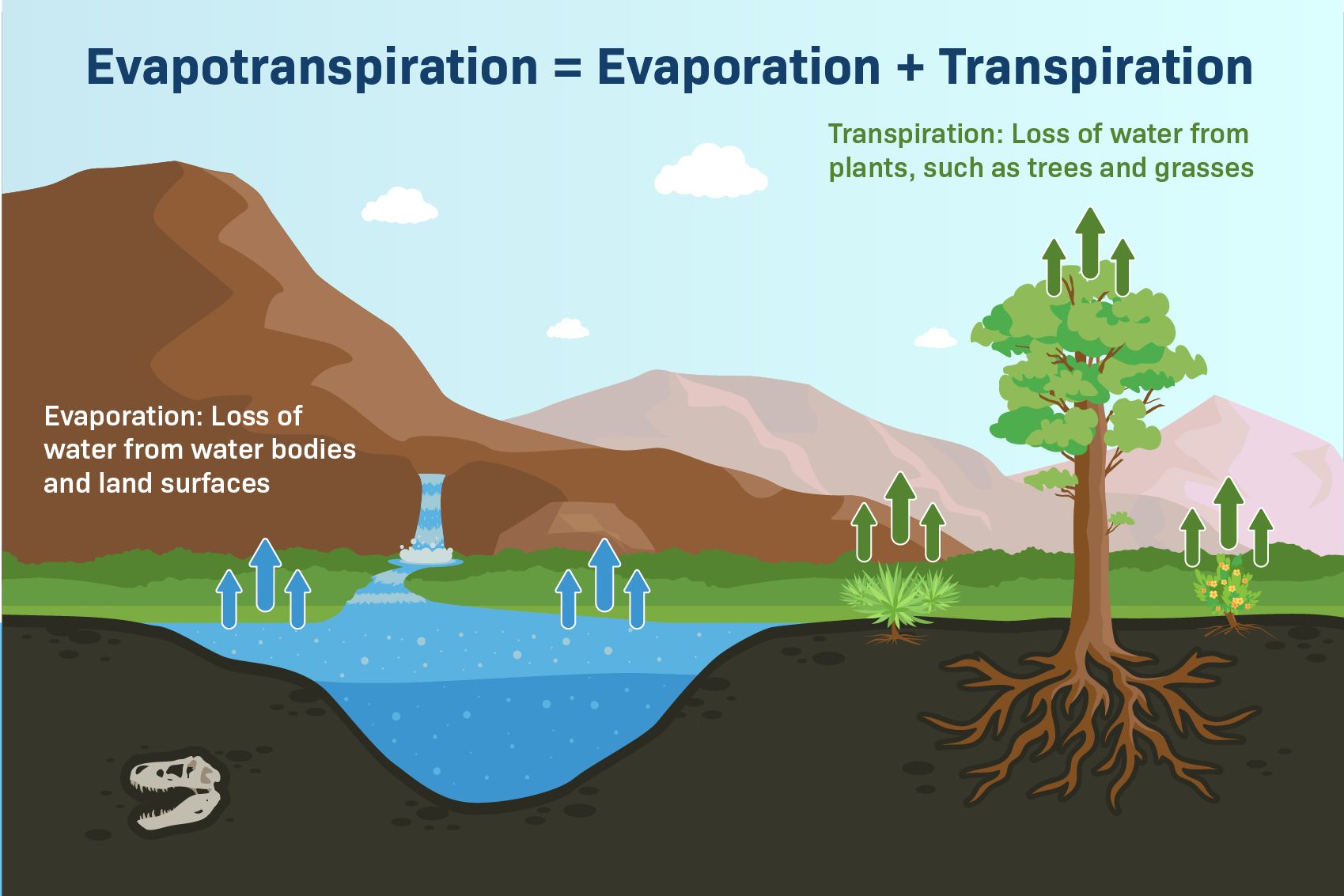
Evapotranspiration might sound like a complex term, but it's a simple concept that plays a crucial role in our environment. Evapotranspiration combines two processes: evaporation from soil and water surfaces and transpiration from plants. Together, these processes move water from the land to the atmosphere. This natural cycle helps regulate temperature, supports plant growth, and influences weather patterns. Understanding evapotranspiration can help us better manage water resources, predict droughts, and improve agricultural practices. Whether you're a student, gardener, or just curious about nature, these 35 facts about evapotranspiration will give you a deeper appreciation for this vital process.
What is Evapotranspiration?
Evapotranspiration is a key process in the water cycle, combining evaporation from soil and water surfaces with transpiration from plants. This phenomenon plays a crucial role in weather patterns, agriculture, and water resource management.
- Evapotranspiration is the sum of evaporation and plant transpiration from the Earth's land and ocean surface to the atmosphere.
- It helps regulate temperature by cooling the environment through the process of water vapor release.
- This process is essential for maintaining the water balance in ecosystems.
- It influences local and global climate patterns by affecting humidity and precipitation levels.
- Evapotranspiration rates vary depending on factors like temperature, humidity, wind speed, and solar radiation.
Factors Affecting Evapotranspiration
Several elements influence the rate of evapotranspiration, making it a dynamic and complex process.
- Temperature: Higher temperatures increase the rate of evapotranspiration as more energy is available to convert water into vapor.
- Humidity: Lower humidity levels lead to higher evapotranspiration rates because dry air can hold more water vapor.
- Wind Speed: Wind helps remove the saturated air around plants and water bodies, increasing evapotranspiration.
- Solar Radiation: More sunlight provides the energy needed for evaporation and transpiration.
- Soil Moisture: Adequate soil moisture is necessary for plants to transpire; dry soil limits this process.
Measuring Evapotranspiration
Understanding how to measure evapotranspiration is vital for agriculture, hydrology, and climate science.
- Lysimeters: These devices measure the amount of water lost through evapotranspiration by weighing a soil sample.
- Eddy Covariance Systems: These systems measure the exchange of water vapor between the land surface and the atmosphere.
- Remote Sensing: Satellites can estimate evapotranspiration over large areas by analyzing surface temperatures and vegetation indices.
- Pan Evaporation: This method uses a pan filled with water to measure the rate of evaporation, which can be correlated with evapotranspiration.
- Empirical Models: Models like the Penman-Monteith equation use weather data to estimate evapotranspiration rates.
Importance in Agriculture
Evapotranspiration is crucial for crop management and irrigation planning.
- Irrigation Scheduling: Knowing evapotranspiration rates helps farmers determine when and how much to water crops.
- Crop Yield: Proper management of water through understanding evapotranspiration can lead to higher crop yields.
- Water Conservation: Efficient irrigation based on evapotranspiration data conserves water resources.
- Drought Management: Monitoring evapotranspiration helps predict and manage drought conditions.
- Soil Health: Maintaining optimal soil moisture through evapotranspiration insights ensures healthy soil and plant growth.
Impact on Water Resources
Evapotranspiration significantly affects water availability and distribution.
- Water Cycle: It is a critical component of the water cycle, returning water to the atmosphere.
- Groundwater Recharge: Reduced evapotranspiration can lead to increased groundwater recharge.
- Surface Water Levels: High evapotranspiration rates can lower river and lake levels.
- Water Management: Understanding evapotranspiration helps in planning and managing water resources effectively.
- Climate Change: Changes in evapotranspiration patterns can indicate shifts in climate and water availability.
Role in Climate and Weather
Evapotranspiration influences weather patterns and climate systems.
- Humidity: It contributes to atmospheric humidity, affecting weather conditions.
- Precipitation: Areas with high evapotranspiration can experience increased precipitation due to more water vapor in the air.
- Temperature Regulation: By releasing water vapor, evapotranspiration helps cool the environment.
- Climate Models: Accurate evapotranspiration data is essential for climate modeling and prediction.
- Heatwaves: Reduced evapotranspiration during heatwaves can exacerbate high temperatures.
Technological Advances in Studying Evapotranspiration
Modern technology has enhanced our ability to study and understand evapotranspiration.
- Drones: Equipped with sensors, drones can collect detailed evapotranspiration data over large areas.
- Machine Learning: Algorithms can analyze vast amounts of data to predict evapotranspiration rates more accurately.
- IoT Sensors: Internet of Things (IoT) devices provide real-time data on soil moisture and weather conditions.
- Climate Models: Advanced climate models incorporate evapotranspiration data to improve weather forecasts.
- Big Data: Large datasets from various sources help in understanding and predicting evapotranspiration patterns.
Final Thoughts on Evapotranspiration
Evapotranspiration plays a huge role in our environment. It’s the process where water moves from the land to the atmosphere through evaporation and plant transpiration. This natural cycle helps regulate temperature, supports plant growth, and maintains the water balance in ecosystems. Farmers rely on evapotranspiration data to manage irrigation, ensuring crops get the right amount of water. Urban planners use it to design green spaces that cool cities and reduce runoff. Understanding this process can help us make better decisions about water use and conservation. So, next time you see a plant or feel the cool breeze after a rain, remember the invisible work of evapotranspiration. It’s a small word with a big impact on our world.
Was this page helpful?
Our commitment to delivering trustworthy and engaging content is at the heart of what we do. Each fact on our site is contributed by real users like you, bringing a wealth of diverse insights and information. To ensure the highest standards of accuracy and reliability, our dedicated editors meticulously review each submission. This process guarantees that the facts we share are not only fascinating but also credible. Trust in our commitment to quality and authenticity as you explore and learn with us.
